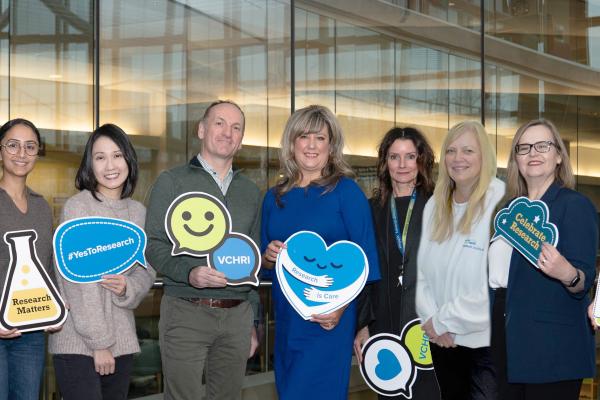
"I say yes to participate in research because it is one of the ways that we can make progress toward the discovery of new treatments and therapies for Parkinson’s disease."
– Margaret Hanson, Squamish
Now retired from working as a project manager in the tech industry, Margaret Hanson’s active lifestyle is intimidating. The 68-year-old rock climbs, mountain climbs, hikes, skis, goes on backpacking trips — mainly with her husband of 18 years, Tony — and still seems to have energy to spare. However, in December 2016, just nine months after celebrating her retirement, Hanson received news that no one ever wants to hear.
“I was diagnosed with Parkinson’s disease. It was devastating,” Hanson shares. “I had noticed tremors several years before, especially in my right hand. It was not able to keep up with my left hand when I typed, and it struggled with things like turning door knobs and chopping vegetables in the kitchen.”

Hanson worked with a neurologist to establish a treatment regime to stave off worsening symptoms, giving her more time to thrive. Parkinson’s is an incurable neurodegenerative disease that affects the basal ganglia — an area in the centre of the brain — that plays an important role in functions such as movements, speech and emotions.
“I had stopped wanting to talk because no one could understand me,” recalls Hanson, whose Parkinson’s made her mumble her words. Within two months of starting to take the prescription dopamine replacement medications carbidopa and levodopa, Hanson noticed dramatic improvements in her speech, motor skills and mood. “I also noticed that the medications made me feel less tired and lethargic,” she adds.

Taking medications at regular intervals is key for reducing symptoms of tremor, stiffness, depression, anxiety, sleep difficulties and slowed movements and speech that negatively impact quality of life. However, dopamine replacement medications tend to decrease in efficacy over the course of several hours, making the right medication schedule a difficult goalpost to attain.
It was only within the past two years that Hanson began noticing the effects of what is known as the medication ‘wearing off’ phenomenon. When medications wear off, symptom recurrence can be physically uncomfortable and stressful, and may negatively impact the brain. However, taking more medication too soon to avoid wearing-off symptoms may lead to dyskinesia — involuntary writhing movements.
Gathering data on biomarkers for a predictive wearing-off model
Hanson was one of several participants in the Individualized, machine-learning approach for prediction of medication ‘off’ episodes in Parkinson’s disease (PD Sweat OFF) study led by Vancouver Coastal Health Research Institute researcher Dr. Martin McKeown. The ongoing clinical trial is investigating a novel tool that could help optimise medication scheduling for symptom management.

Study participants wear an EmbracePlus advanced smartwatch equipped with a sensor that detects subtle physiological changes in the body that may indicate medication wearing off, such as electrodermal activity in the form of increased skin sweating, as well as blood pressure and heart rate.
“We are studying how the body changes before people with Parkinson’s even realise that their medication is wearing off,” says McKeown. “By analysing subtle patterns in physiological signals like movement, heart rate or skin changes, we hope to predict these wearing off episodes in advance. This could help people take their medication at the right time, before symptoms return, leading to better daily control and quality of life.”
“Our hope is that wrist-worn technology can help patients know when their medication is working optimally and when it is beginning to wear off, alerting them to take their medication at the optimal time for symptom management and improved quality of life.”
Study participants wore the wrist sensor for 72 hours, noting in a mobile app questionnaire how they felt and their medication status on an hourly basis — excluding while sleeping. With help from artificial intelligence computer algorithms, researchers are analysing the data to identify patterns that could lead to a predictive tool for wearing-off symptoms.
“Participating in this study drove home for me the importance of taking my medication in a timely manner,” says Hanson. “If something like this smartwatch became available to help me with staying on top of my medication, I would probably try it.”
This is one patient's story of participating in a research study. Your experience may differ. Learn about clinical trials before participating.


